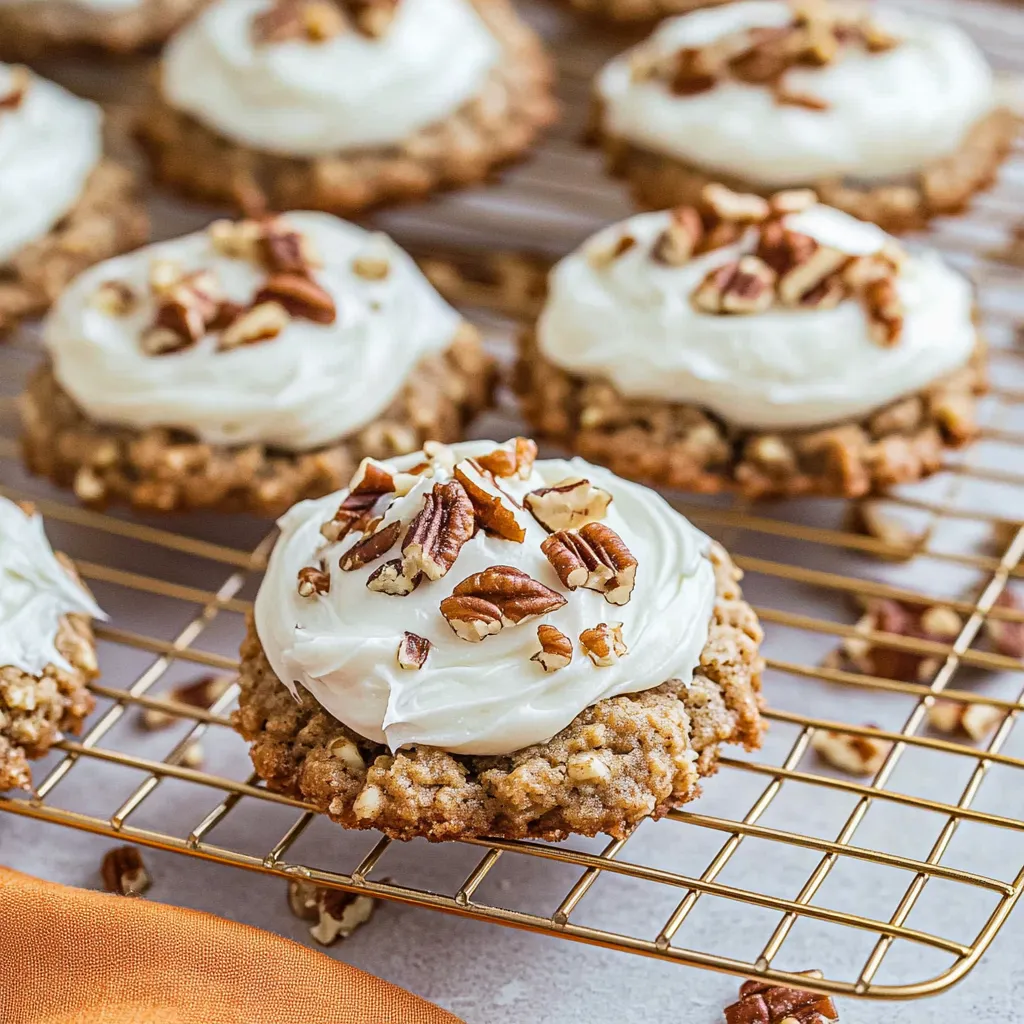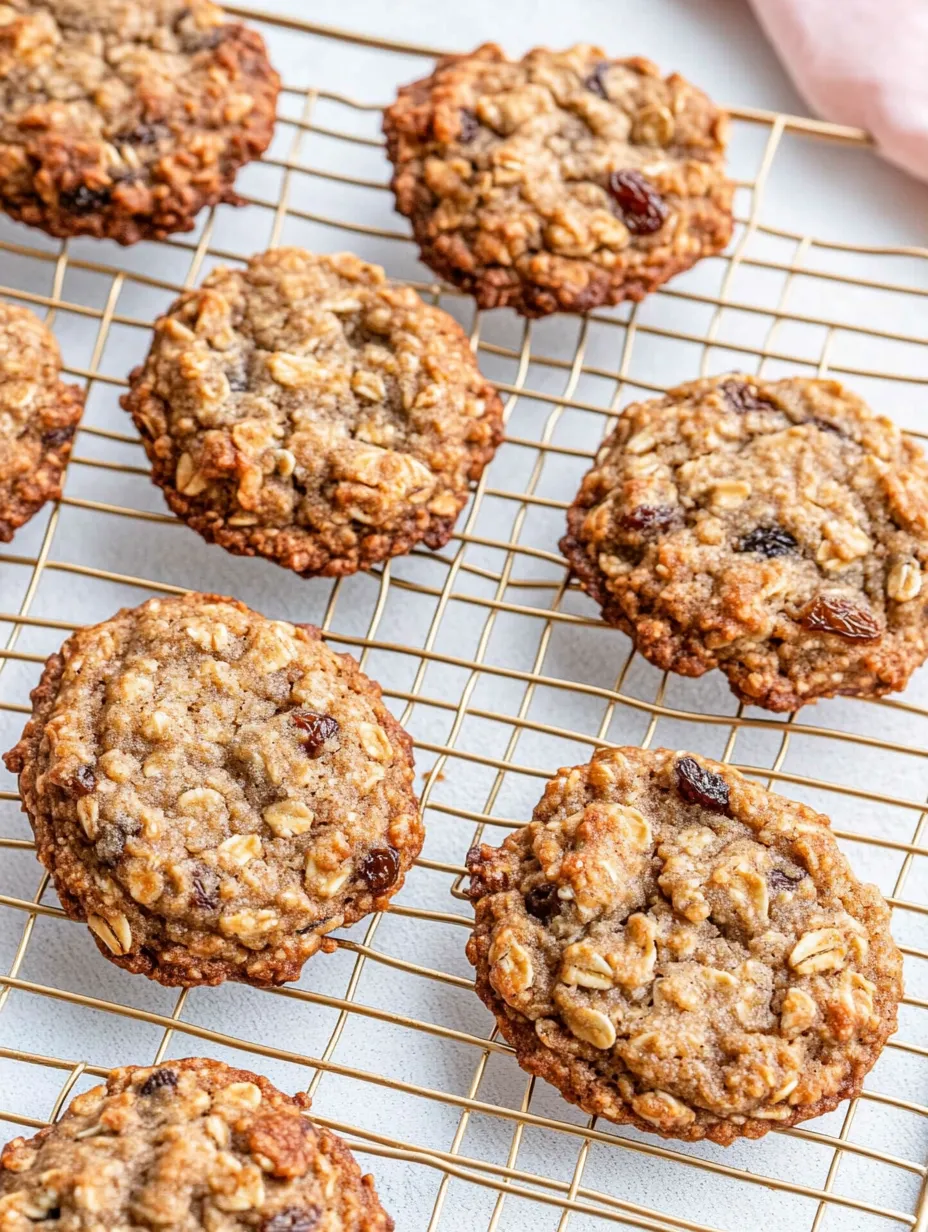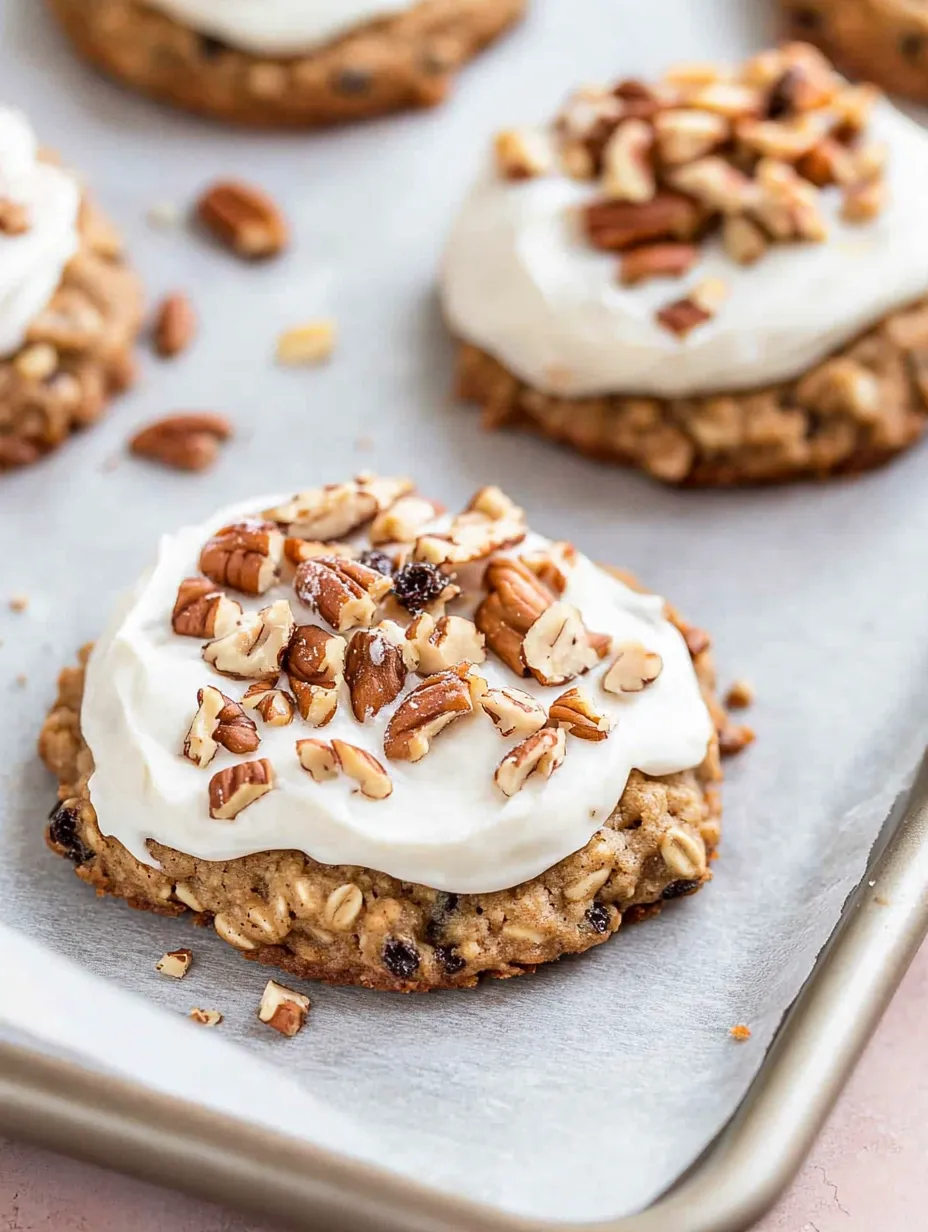 Pin it
Pin it
Soft carrot cookies blend the juicy flavor of carrot cake with the comforting texture of oatmeal cookies, creating an irresistible treat. Every bite surprises you with plump raisins and that signature carrot cake taste. Topped with creamy cream cheese frosting and crunchy nuts, these cookies become a portable dessert that's perfect for any occasion and brings the magic of classic carrot cake in a handy format.
The first time I made these carrot cookies for a family gathering, they vanished within minutes. My uncle, who normally hates carrot cake, took one just to be polite but came back three more times for extras. That's always my sign of a winning dish.
Carefully Selected Ingredients
- Traditional rolled oats: they create the tasty foundation for these cookies and give them a pleasantly chewy texture
- Freshly grated carrots: they add natural sweetness, moisture and the unique taste of carrot cake
- Dark brown sugar: with its intense molasses flavor, it complements the carrots' sweetness and keeps cookies nice and soft
- Cornstarch: it's the secret for particularly tender cookies with just the right consistency
- Cinnamon: it brings that warm, spicy note that's characteristic of carrot cake
- Plump raisins: they create little bursts of flavor in every bite
- Creamy cream cheese frosting: it turns the cookies into a luxurious dessert
- Chopped walnuts or pecans: they add a delicious crunch that perfectly complements the soft texture
 Pin it
Pin it
Detailed Preparation Steps
- Getting the dry ingredients ready:
- In a medium bowl, mix the flour with cornstarch, baking soda, salt and cinnamon really well. Cornstarch isn't a regular addition, but it's the key to an extra tender texture. Whisking makes sure all ingredients are spread out evenly without lumps.
- Working with wet ingredients:
- In a large bowl, beat the slightly cooled melted butter with dark brown sugar using an electric mixer on high speed for about two minutes. Don't forget to scrape down the sides now and then for an even mix. The mixture should become airy and slightly lighter. Then add eggs and vanilla extract and beat for another minute until you get a smooth blend.
- Putting the dough together:
- Add the flour mixture to the butter mixture and stir on low speed just until combined. Too much mixing can make cookies tough, so be careful. Now add the rolled oats, mixing briefly. Finally, gently fold in the freshly grated carrots and raisins. Use a silicone spatula to softly incorporate the ingredients without pushing too much air out of the dough.
- Letting the dough rest:
- Cover the finished dough with plastic wrap and put it in the fridge for at least an hour. This step matters a lot so the oats can soak up moisture and flavors have time to develop. The cooling period also keeps cookies from spreading too much during baking.
- Shaping and baking the cookies:
- Preheat your oven to 350°F and line a baking sheet with parchment paper. Form cookies using 2-3 tablespoons of dough each and place them on the sheet with plenty of space between them. Bake them for 11-13 minutes. The perfect time to take them out is when the edges become slightly golden while the center still looks soft. The cookies will keep cooking on the hot sheet.
- Cooling and finishing:
- Let the cookies sit for about 5 minutes on the sheet after baking before carefully moving them to a rack to cool completely. If you're going with frosting, make sure the cookies are totally cool before applying it. Make a half portion of cream cheese frosting and generously cover each cookie. Sprinkle with chopped walnuts or pecans for a perfect crunch.
When I first made these cookies for my kids, they were skeptical because of the carrots. After the first bite, all fears disappeared, and since then, they ask for them regularly. My daughter especially loves helping spread the frosting and sprinkling the nuts, making this a perfect family project.
Serving Ideas
These versatile carrot cookies can be presented and served in different ways. For a casual coffee meet-up, serve the cookies without frosting on a rustic wooden board, garnished with a few fresh carrot slices for a decorative touch. If you want a fancier dessert, create little sandwiches by putting two cookies together with a thicker layer of cream cheese frosting and rolling the edges in finely chopped caramelized nuts. For a brunch buffet, stack the frosted cookies in a pyramid on a tiered stand and decorate with small marzipan carrots. Serve the cookies slightly chilled if topped with frosting, or at room temperature without frosting to bring out their full flavor. A perfect drink to go with them is a mild chai tea or espresso, whose spicy notes beautifully match the cinnamon flavors in the cookies.
Creative Variations
The basic recipe for these carrot cookies offers many possibilities for creative spins. Try a tropical twist by swapping raisins for dried diced pineapple and adding coconut flakes to the dough. You can trade the nuts in the frosting for roasted pistachios for an unusual combo of colors and flavors. For a spicier version, add ground ginger, cardamom and a pinch of ground cloves to the dough, which go wonderfully with carrots. Play around with the frosting by mixing in some orange zest or a touch of maple syrup. For a healthier take, you can replace part of the sugar with honey and use whole wheat flour instead of white flour. As a fall variation, add some pumpkin puree to the dough and adjust the spices accordingly for a carrot-pumpkin hybrid cookie that's particularly tasty during the cold season.
 Pin it
Pin it
Storage and Shelf Life
These carrot cookies keep very well and can be made ahead without any problem. Store unfrosted cookies in an airtight container at room temperature, where they'll stay fresh for up to five days. Cookies with cream cheese frosting should be kept in the fridge and will last up to a week there. Take them out about 15 minutes before serving so they reach a nice temperature and develop their full flavor. For longer storage, both versions can be frozen: unfrosted cookies can be wrapped in plastic wrap then placed in a freezer bag for up to three months. It's better to freeze frosted cookies individually on a baking sheet before stacking them, to avoid messing up the frosting. To thaw, leave the cookies in the fridge overnight or at room temperature for about an hour. It's also very handy to freeze the raw dough as pre-formed balls, which you can then bake directly from the freezer just by adding 1-2 minutes to the baking time.
The magic of these carrot cookies lies in their ability to combine the best of two worlds: the comforting side of an oatmeal cookie and the nostalgic sweetness of carrot cake. When I created this recipe, I wanted to make something that was more than just a cookie with carrots, but a taste experience that captures the essence of a good carrot cake. The result exceeded my expectations. The combo of the moist sweetness from carrots and the chewy cookie texture, crowned with creamy cream cheese frosting, creates a dessert that's both familiar and surprising. These cookies are now a regular part of my baking repertoire and are always the first to disappear at family gatherings, which is probably the biggest compliment for any recipe.
Frequently Asked Questions
- → Can the raisins be left out?
- Absolutely! Swap them for dried cranberries, chopped dried apricots, or even chocolate. If you skip them entirely, toss in a bit more grated carrot to keep the texture soft.
- → Why chill the dough?
- Chilling lets the oats absorb moisture, stops the cookies from spreading too much, and boosts the flavors. You'll get thick and chewy cookies.
- → Can whole wheat flour replace white?
- It can, but the cookies will turn out denser and taste earthier. Start with half whole wheat and half white flour, then adjust to your liking.
- → Is the cream cheese frosting necessary?
- No, they’re tasty on their own. But the frosting gives them carrot cake vibes. A light sugar glaze or a sprinkle of powdered sugar works too!
- → How should I grate the carrots?
- Grate them finely so they mix well into the dough and cook evenly. Use a fine grater or a food processor. Avoid big chunks, as they may make cookies soggy or unevenly cooked.
